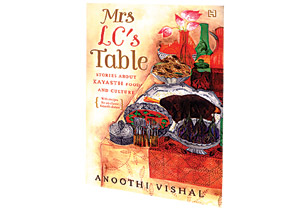It is telling that these “tasteful” tales begin with things Mrs LC won’t eat. She cooked them, but would not eat them, a vegetarian who refuses even certain vegetables and legumes due to tastebuds and traditions.
Mrs LC is the author’s grandmother—and Vishal’s love and awe breathe life into these stories, even as she claims “gourmet” status for a fussy eater. Perhaps the lens of childhood viewing senior adulthood is responsible. Indeed, there is a huge lacuna around how Mrs LC’s table manages to be laden without much experience or involvement on her part.
One might consider it a misnomer—it was never Mrs LC’s table but the furniture, like her name, rightfully her husband’s even. Or find it plain confuzzling—like a recipe for charnamrit from a supposedly emancipated woman speaking to a supposedly emancipated reader!
It is an absorbing picture of the Kayasth community, sure, painted by a reluctant subscriber to that caste identity. It defines itself much by exclusion—and an odd ownership of that which is also disowned, disavowed, distinct, like Mrs LC lauding meat dishes she’s never tasted. It celebrates skills learnt, not personally acquired yet identified with—like cooking keema kofte perfectly as an upper-caste Hindu vegetarian matriarch with “good hands”. Vishal claims for Kayasths an instinctive flair for cooking; yet the facts point to indoctrination and copycattery. She does acknowledge the culture’s Ganga-Jamuni contradictions—“syncretic”, superior, sometimes stifling. This results in colourful cobbling, like kele ki machchli, ‘fish’ made from raw banana.
It is a brave journey: to claim one’s caste identity while acknowledging its problematic nature. Yet the depths of the author’s privilege are not fully plumbed. The tales are well told, pretty stories like those pretty plates of Mrs LC’s table. Read it for a modern Indian woman’s struggle to reconcile the dark side of cultural identity with the bond to gatekeeping family figures. Read it for the food history. But beyond that is a bitter pill of inter-community tensions elided, foibles papered over with nostalgia, tied up in parochial straitlaces.




